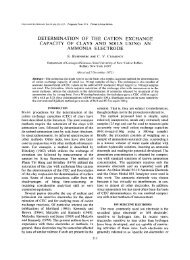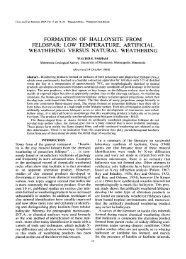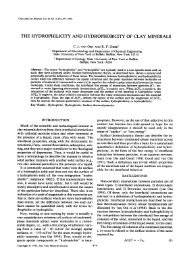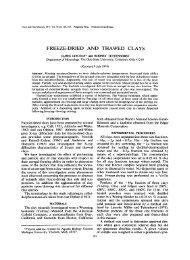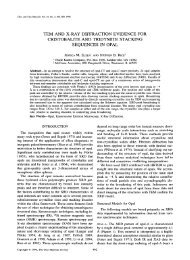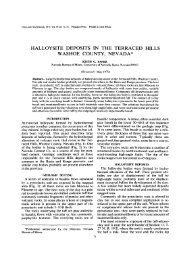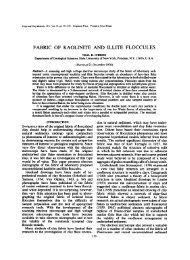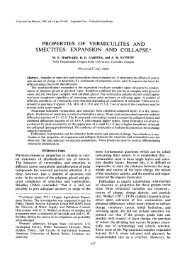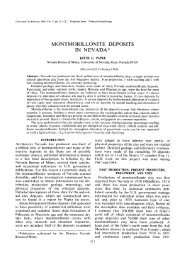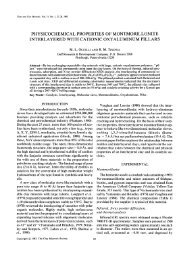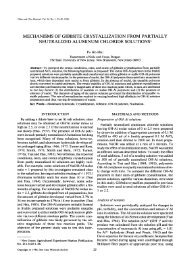mineralogical and geochemical study of clay mineral ...
mineralogical and geochemical study of clay mineral ...
mineralogical and geochemical study of clay mineral ...
You also want an ePaper? Increase the reach of your titles
YUMPU automatically turns print PDFs into web optimized ePapers that Google loves.
I 2 3<br />
~~ ,<br />
iO.<br />
4 5<br />
CLAY MINERAL TRANSFORMATIONS 369<br />
I S<strong>and</strong>s<br />
2 CLays<br />
$ Limestones<br />
4 Dolomites<br />
5 Salt<br />
6 Sulfate<br />
Fig. 3. Variations in the chemical composition <strong>of</strong> the<br />
<strong>clay</strong> fraction <strong>of</strong> different sedimentary facies.<br />
layers, first irregular, then regular (corrensite),<br />
<strong>and</strong> result finally in a well-crystallized chlorite.<br />
This transformation is accompanied by an increase<br />
in crystallite size.<br />
The increase in the amount <strong>of</strong> magnesium con-<br />
tained in the <strong>clay</strong>s is accompanied by a decrease<br />
C.C.M. Vol. 16No. 5-D<br />
in aluminum <strong>and</strong> silicon. It is not, however,<br />
because <strong>of</strong> an increase in dissolved magnesium<br />
that this transformation occurs, since whole rock<br />
analyses show that magnesium remains constant<br />
across the basin, but is rather a function <strong>of</strong> supply<br />
<strong>and</strong> dem<strong>and</strong>. Near the coast, degraded particles<br />
are numerous <strong>and</strong> the concentration <strong>of</strong> available,<br />
dissolved magnesium is too low to fill all the poten-<br />
tial magnesium sites. Farther from the coast,<br />
the number <strong>of</strong> particles decreases <strong>and</strong> each <strong>of</strong> them<br />
has available more magnesium. But <strong>clay</strong> <strong>mineral</strong>s<br />
are not the only sites possible for magnesium; it<br />
is incorporated into carbonates also. This explains<br />
why in carbonate facies, especially dolomitic<br />
facies, <strong>clay</strong> <strong>mineral</strong>s are transformed only slightly.<br />
On the other h<strong>and</strong>, in saline environments where<br />
cation concentrations are not sufficient for highly-<br />
soluble magnesium chloride or sulfate to form,<br />
magnesium remains entirely available for <strong>clay</strong>s<br />
which can thus undergo extreme changes. But even<br />
in these super-saline environments, the competition<br />
for magnesium, though not vigorous, is none the<br />
less important. In the drill hole at Laveron, alter-<br />
nate layers <strong>of</strong> massive salt <strong>and</strong> <strong>clay</strong> correspond<br />
to alternate populations <strong>of</strong> either corrensite or<br />
chlorite respectively (Lucas, 1962; Millot, Lucas,<br />
<strong>and</strong> Wey, 1963). When salts precipitate, they<br />
remove magnesium <strong>and</strong> <strong>clay</strong> <strong>mineral</strong>s do not alter<br />
beyond the corrensite stage. When <strong>clay</strong>s are the<br />
principal materials deposited, all the magnesium<br />
is available to them <strong>and</strong> the <strong>clay</strong> <strong>mineral</strong>s reach<br />
the final aggradation stage <strong>of</strong> chlorite.<br />
DISCUSSION OF MINERAL TRANSFORMATIONS<br />
Transformation or ne<strong>of</strong>ormation<br />
One may possibly conceive <strong>of</strong> the <strong>mineral</strong>s<br />
found in the Triassic <strong>clay</strong>s as resulting from<br />
ne<strong>of</strong>ormation, i.e. precipitated from ions in<br />
solution. Two arguments, however, oppose this<br />
idea.<br />
1. The <strong>clay</strong> <strong>mineral</strong>s form a continuous<br />
sequence across the Jura Basin, passing smoothly<br />
from one type to another. Ne<strong>of</strong>ormation would<br />
require imagining precipitation <strong>of</strong> irregular mixed-<br />
layer <strong>mineral</strong>s in a precarious equilibrium, across<br />
a changing environment.<br />
2. The ne<strong>of</strong>ormation <strong>of</strong> well-crystallized illite<br />
<strong>and</strong> chlorite in a sedimentary basin does not appear<br />
possible. In fact, these <strong>mineral</strong>s consist <strong>of</strong> highly-<br />
charged silicate layers. They have been syn-<br />
thesized by many workers under high temperature<br />
<strong>and</strong> pressure, but never under pressure <strong>and</strong> tem-<br />
perature conditions which exist at the earth's<br />
surface. Thermodynamic conditions at the surface<br />
do not permit the ne<strong>of</strong>ormation <strong>of</strong> <strong>mineral</strong>s with<br />
electrically-unbalanced charges on their layers,<br />
which require compensating cations for electric



